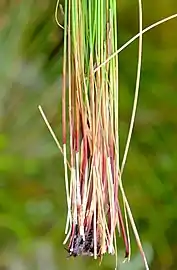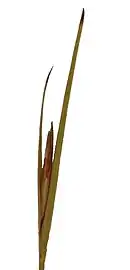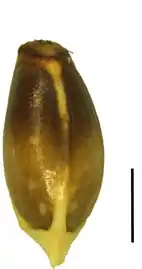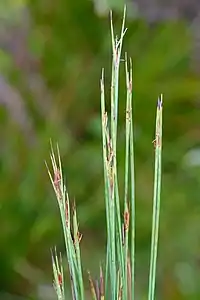Schoenus quadrangularis
Schoenus quadrangularis is a species of sedge endemic to mountainous of southern South Africa.[1]
| Schoenus quadrangularis | |
|---|---|
 | |
| Square veldrush | |
| Scientific classification | |
| Kingdom: | Plantae |
| Clade: | Tracheophytes |
| Clade: | Angiosperms |
| Clade: | Monocots |
| Clade: | Commelinids |
| Order: | Poales |
| Family: | Cyperaceae |
| Genus: | Schoenus |
| Species: | S. quadrangularis |
| Binomial name | |
| Schoenus quadrangularis Boeckeler | |
 | |
| Documented collection localities in South Africa | |
| Synonyms[1] | |
| |
Description
Schoenus quadrangularis is a unique species amongst the southern African Schoenus that has deeply ridged, quadrangular (4-angled) stems directly below the flowering heads (inflorescences).[1] Plants of this species often are bluish-tinged in colour.
Preliminary evidence suggests that the southern African Schoenus have a tendency to form hybrids with each other, which partially explains why they can be difficult to identify.[2] However, it is not certain at this point whether S. quadrangularis forms hybrids with other southern African Schoenus species.[1]
 Bases of flowering stems (culms)
Bases of flowering stems (culms) Flowering head
Flowering head Spikelet
Spikelet Nutlet (black scale bar is 1mm)
Nutlet (black scale bar is 1mm)
Taxonomy
Schoenus quadrangularis is a species in family Cyperaceae, tribe Schoeneae, a clade that includes other notable genera such as Costularia, Gahnia, Lepidosperma, Oreobolus and Tetraria.[1][3][4] The most closely related species to Schoenus quadrangularis are other species in the Epischoenus group of southern African Schoenus.[1]
The genus Tetraria once included species from the southern African Schoenus; however, both molecular and morphological evidence suggests that the two genera are evolutionary distinct.[5] To ensure that this group of sedges is monophyletic (i.e. the genus only has closely related species), several species of Epischoenus and the southern African Tetraria were transferred into Schoenus.[5] In the field, the southern African Schoenus can be distinguished from Tetraria species by their lack of stem leaves and the absence of reticulate sheaths at the bases of the flowering stems.[5]
Distribution and habitat
The distribution of Schoenus quadrangularis ranges from the Cape Peninsula in the west to the Groot Winterhook Mountains in the Eastern Cape Province of southern South Africa.[1] This species has been mostly observed growing in damp sites in the mountains, with elevations ranging from 82-1370 m.[1]
Gallery
 Flowering heads (inflorescences)
Flowering heads (inflorescences) Flowering heads (inflorescences)
Flowering heads (inflorescences)
References
- Elliott, T.L.; Muasya, A.M. (2020). "A taxonomic revision of the Epischoenus group of Schoenus (Cyperaceae, tribe Schoeneae)". South African Journal of Botany. 135: 296–316. doi:10.1016/j.sajb.2020.08.029.
- Levyns, M. (1947). "Tetraria and related genera, with special reference to the flora of the Cape Peninsula". Journal of South African Botany. 13: 73–93.
- Viljoen, J.-A.; Muasya, A.M.; Barrett, R.L.; Bruhl, J.J.; Gibbs, A.K.; Slingsby, J.A.; Wilson, K. L.; Verboom, G.A. (2013). "Radiation and repeated transoceanic dispersal of Schoeneae (Cyperaceae) through the southern hemisphere". American Journal of Botany. 100 (12): 2494–2508. doi:10.3732/ajb.1300105.
- Larridon, I.; Bauters, K.; Semmouri, I.; Viljoen, J.-A.; Prychid, C.J.; Muasya, A.M.; Bruhl, J.J.; Wilson, K.L.; Senterre, B.; Goetghebeur, P. (2018). "Molecular phylogenetics of the genus Costularia (Schoeneae, Cyperaceae) reveals multiple distinct evolutionary lineages". Molecular Phylogenetics and Evolution. 126: 196–209. doi:10.1016/j.ympev.2018.04.016.
- Elliott, T.L.; Muasya, A.M. (2017). "Taxonomic realignment in the southern African Tetraria (Cyperaceae, tribe Schoeneae; Schoenus clade)". South African Journal of Botany. 112: 354–360. doi:10.1016/j.sajb.2017.06.011.